|
|
|

|
|
One intrepid woman, 45 songwriters, 43 separate interviews, done in five countries over a period of four years. Here's the story of how Songwriters Speak went from an ambitious concept to a published book.
|
 |
| I had been loving and living music forever, as documented unashamedly in my confessional Music & Mayhem page, my 2SM page, and elsewhere on this site. I had been writing professionally about music as a journalist for many years also; a lot of that work can be read in the other areas of the Writer section. Australian music had always played a large part in the soundtrack of my life.
But ironically, the genesis of this mammoth project, focusing on Australasian songwriters, was in California.
|
| It all started in late 1997 after a seminal trip to Los Angeles, which made me want to read as many important books on popular music as I could. I ordered a huge box of books from Amazon.com, including Paul Zollo's Songwriters on Songwriting. I saw that there was a style of interviewing about music, specifically about creating and crafting music, that was a cut above the usual style of music interviewing. I devoured Zollo's book, which has since been updated in a fourth, even more expanded edition than the one I have pictured at right. |
|
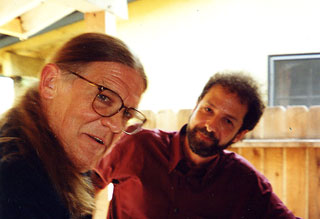 Henry Diltz and Paul Zollo in 2002
Henry Diltz and Paul Zollo in 2002
|
During time in LA in 1998 I found myself face to face with Paul Zollo at the opening of an exhibition by our mutual friend Henry Diltz. I introduced myself and we instantly became friends.
Both Paul and Henry have been very influential figures in my life for several years, and Songwriters Speak might never have happened if it weren't for those two.
|
| Paul became the editor of Performing Songwriter magazine, and commissioned me to write various pieces on songwriters. Most of the interviews I did for the magazine were with US-based songwriters, but in September 2000 Paul asked me to do a short piece on Australian country music artist Kasey Chambers. I didn't know it at the time, but it was the first interview for what would become my first book. |
| Before the interview was even published, I had started working at the Australasian Performing Right Association (APRA), as their Manager of Communications and Public Affairs. |
 |
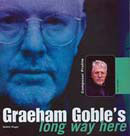 |
In that role, as editor of APrap magazine, I interviewed many songwriters and composers. One of my first major profiles was on Little River Band songwriter, Graeham Goble. We spent three hours talking about his work. He was so impressed with my knowledge of his repertoire and my interviewing technique, that when I mentioned that I would love to write a whole book of interviews with songwriters, he was very encouraging and said he'd be happy to endorse such an enterprise. That interview became the second that would be used in Songwriters Speak. |
|
| Representing APRA at the Tamworth Country Music Festival in January 2001, I interviewed the songwriters who had been nominated for Song of the Year at the Golden Guitar Awards. |
|
|
| I made an instant connection with one of those nominees, Graeme Connors, and shared with him my vision for a book of interviews with Australian and New Zealand songwriters. Surely, we agreed, our popular music poets were as worthy of a book as those in America and England. He was very enthusiastic and insistent that I follow through on the idea. I also interviewed John Williamson and Don Walker for the story; things we discussed then found their way into the interviews I did with each of them for the book later on.
Also in Tamworth that year I met Norm Lurie, who runs the book and music publishing company Music Sales in Australia, and is on the board of AMCOS, the publishing/mechanical rights arm of APRA. I told him about my idea, and he urged me to put together a book proposal.
|
 |
|
My working title was Australian Songwriters on Songwriting. The big difference would be that while Paul had amassed his interviews over a ten-year period of editing a journal called Songtalk, I was going to do my interviews purposefully for my book, in a much shorter time.
For my proposal, I put together an outline, my marketing ideas, my proposed chapter list, and included three sample interviews, one of which was INXS's Andrew Farriss, who, in the course of 2001, I also interviewed for APrap.
| Andrew very kindly wrote me a letter of endorsement to include in the proposal, as did Graeme Connors and Graeham Goble. |
 |
|
|
|
The proposal took me most of 2001 to write up and get exactly right. When I first sat down to draw up a dream list of songwriters to include in the book, the total came to over 100. This was obviously too many, given that the interviews would be long and detailed, so I progressively whittled down the list until I came to the 62 I listed in my proposal. It was still too big for some publishers; one was interested if I pared the list back to only fifteen songwriters! That wasn't my idea at all. The concept was to feature as many songwriters as possible in order to trace the development of music in Australia through the songwriting, spanning a period of at least 50 years, showing the influences down the line. It was ambitious in scope and required a publisher with foresight. |
| It would require a publisher with patience, too, as it would take me some time to pull it all together once I had the deal. |
 |
My agent, Rachel Skinner, who took me on as a client in mid-2002, told me then, and has reminded me many times since, that in the book publishing world projects can move slower than glaciers. |
After years in the fast-moving world of newspaper and magazine deadlines, this took some getting used to. But it was some consolation as the process of finding the right publisher and then getting a signed contract took time.
Meanwhile, I continued writing for APrap, and scored an interview with Paul Kelly, which I knew for sure I would use in my songwriters book.
|
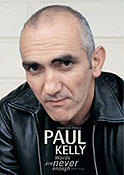 |
| I also took advantage of a personal trip to Los Angeles in August and September 2002 to interview two Australian songwriters living there — John Farrar and Steve Kipner. Both were happy to spend a few hours each talking to me about their songwriting and I knew, from those interviews, that this book would be every bit as important and special as I had believed.
John Farrar and his wife Pat very kindly arranged for me to attend a special party on the Paramount Studios lot to celebrate the launch of the movie Grease on DVD, and watching Olivia Newton-John and John Travolta together performing John Farrar's big hit, "You're The One That I Want", all these years down the track, confirmed for me just how essential good songs are in our lives. It was a magical moment.
|
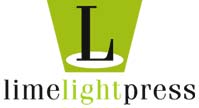 |
In early 2003 Limelight Press, an independent publisher based in Sydney, offered to publish my book. Very exciting!! At which point I threw myself into contacting songwriters, organising interviews for the book and contacting record companies to obtain product to assist with my research. |
I made the first of several interviewing trips to Melbourne, and while there I met with Festival Mushroom Records about getting a stack of CDs from them for my research. Their marketing whiz, Dean McLachlan, loved the project and immediately suggested they put together a CD to go with the book.
Soon after, I left my job at APRA and was able to spend most of my time on the book, and fit in some freelance PR and journalism around it. Within a few months of working full-time on the book, it became obvious that I would have to limit the list of songwriters to a total of 45. Still, I believed I had a terrific hit list and now it was my mission to tick off everyone on it.
|
|
|
| The process of writing a book such as Songwriters Speak is so much more than having a great idea and delivering it. The research and preparation for each interview, dealing with management companies, publicity people and personal assistants, organising travel around Australia and overseas, gathering photos – which often involved arranging special photo shoots – the legalities of getting release forms signed, obtaining clearances to reprint song lyrics, doing extensive fact-checking, transcribing hundreds of hours of recorded interviews, writing and editing... all of that and more went into the finished book.
But by far the most enjoyable part of the four-year project was meeting the songwriters themselves, consolidating existing friendships and forging new ones. Here are some photos of some of the great moments I had on my travels.
|
| Fitting, I think, to start with Glenn Shorrock and his wife, Jo. From the first time I talked to them about the book, they became a couple of my staunchest allies. We had already developed a friendship during my time at APRA, but their help and support during the next two years of making the book a reality were just wonderful. |
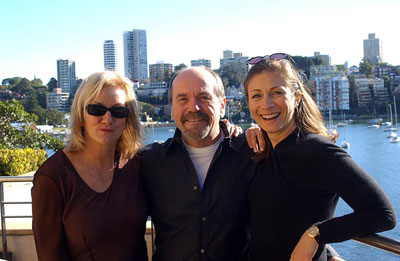 Jo and Glenn Shorrock with Debbie
Jo and Glenn Shorrock with Debbie
|
| These photos were taken at the Shorrocks' Sydney home in July 2004 by Bob King, during the photo shoot we did for Glenn's chapter in the book. My actual interview with him was in May 2003, during a particularly busy few months of interviewing in Sydney and Melbourne. Glenn and Jo even helped to arrange some of the interviews by making calls on my behalf. In fact, in May 2004, just a week before I was getting on a plane to London to do some final interviews, I was having dinner with Glenn and Jo at their home when the phone rang, and it was Terry Britten, calling from his home in Richmond, Surrey, to say hello. "Oh, we're having dinner with our friend Debbie Kruger," Jo told him. "Are you in her book?" Two weeks later, I was at the Britten home. |
 Author with freshly-defuzzed songwriter
Author with freshly-defuzzed songwriter
|
Back in Sydney, at Glenn's photo shoot, he wasn't sure whether he wanted his portrait taken with facial hair or without. So Bob took a couple of rolls of film of him with beard and moustache, and then Glenn went off to shave. He returned looking so smooth and soft that I was compelled to get a little close. I guess he had what one might refer to as a cool change. |
| While Glenn posed for more photos, Jo helped with styling and refreshments. Her enthusiasm and generosity throughout the writing and promotion of my book never waned, and her offer for them to host my official launch at their home was the ultimate compliment. See the Launches page for photos from that big night. |
|
|
| No book on Australasian songwriters, could be in any way taken seriously without paying due attention to that most successful and celebrated songwriting duo, Harry Vanda and George Young.
I had already worked with Harry when I did the publicity for the 2001 APRA Music Awards which focused mainly on a campaign for the Ten Best Australian Songs to celebrate APRA's 75th anniversary. "Friday On My Mind" was predicted to be the number one song and Harry obligingly did some publicity in the lead-up to the big night. When the song was annouced as The Best, there was Harry at the awards to accept a presentation and even play guitar with You Am I.
|
 Debbie and Harry, July 2004
Debbie and Harry, July 2004
|
While George Young is reclusive and stays out of the music scene, living in different homes in the UK and Europe (he did his interview in France in October 2003), Harry is happily working away in Sydney in his super hi-tech Flashpoint Studios, where I interviewed him in July 2003, and where Bob King took photos of him in July 2004. |
| Harry is a funny guy and his conversations are very anecdotal; it was also interesting that he and George differed in some of their recollections, which made for a great chapter of both similar and divergent viewpoints. |
 |
Bob King, considered by many – including myself – to be Australia's best rock photographer, was taking photos of Vanda and Young way back in the '70s when they were writing and producing for Stevie Wright, John Paul Young, William Shakespeare and doing their own Flash and the Pan thing.
|
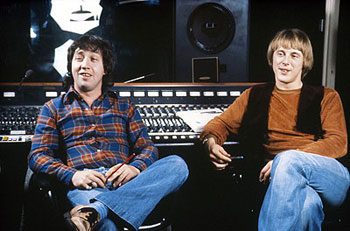 |
Bob took this photo at left, circa 1977, when love was in the air, when it was okay to hate the music if it served the purpose of a good song. Harry told me that George came up with the title for "I Hate the Music" because of negative feelings for the music industry. George told me otherwise. "It was because of frustration with a particular song, not the industry," he said. "We were pissed off because |
a song we were working on was not coming together naturally. This kind of logjam can niggle away at you for weeks, months, years. But it came with the territory. It wasn’t unusual."
|
 Bob aims lens at Harry
Bob aims lens at Harry
|
 Photo King and songwriting king
Photo King and songwriting king
|
| Bob King took numerous photos especially for my book, and on one spectacularly sunny winter's day in 2004, we visited Todd Hunter and Johanna Pigott at their rural home on the NSW South Coast. |
| I'd interviewed Todd and Johanna in July 2003 on a similarly brilliant winter's day, and the photos Bob took of them perfectly captured the mood of the interview. They're a wonderful couple who like to tell each other's stories and, not unlike Harry and George, they had differing memories of certain key songwriting moments. |
 Contemplating the age of reason in rural tranquility
Contemplating the age of reason in rural tranquility
|
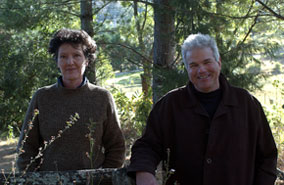 |
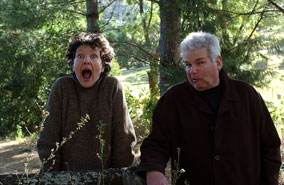 |
| As a member of Dragon for more than 20 years, Todd is used to having his photo taken and likes to ham it up. Johanna is not wild about being photographed, but she graciously submitted. |
 |
| One of the few successful husband/wife songwriting teams in Australia, Todd and Johanna wrote several Dragon hits as well as the phenomenally brilliant "Age of Reason" for John Farnham. |
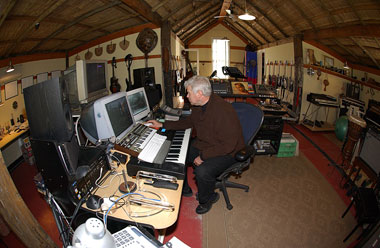 |
Todd's studio, in a renovated barn behind the homestead, is a wondrous and creatively inspiring space. One of the most special moments of my interview with Todd and Johanna in 2003 – and among the most memorable of my many visits to songwriters' studios – was when they played me their original demo of "Age of Reason" with Todd's late brother Marc on lead vocal. |
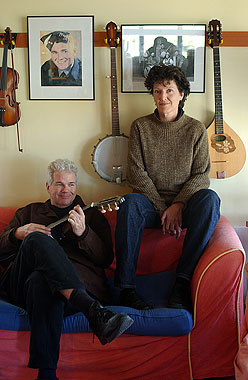 Songwriters in studio
Songwriters in studio
|
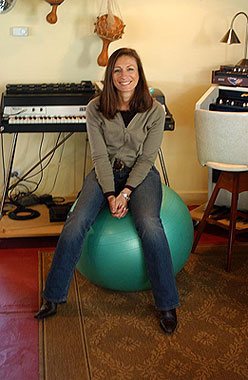 Enraptured author enjoys studio visit
Enraptured author enjoys studio visit
|
| I was a major fan of Dragon in the 1970s, and hearing Todd's stories about those wild, hedonistic days, and both his and Johanna's candid and ultimately sad tales of the demise of the band's songwriting geniuses, Paul Hewson and March Hunter, was quite an experience. It made for what I think is a really fascinating chapter of Songwriters Speak. |
 |
| It's no secret that I am a Sherbet fan from way back; a sometime screamer and constant dreamer in the '70s, a three-time onstage singer with the group in the '80s, and a devoted nostalgia buff to the present day. It's all here; I have no shame. Garth Porter was a canny songwriter-to-order in Sherbet's heyday, and metamorphosed into a major influence in Australian country music industry as a songwriter, producer and artist developer.
Garth can be hard to pin down as he's relentlessly busy. It took several months from first talking about doing an interview to actually doing it, and a fair bit of juggling to get some photos done. He's coy about getting individual profile at the best of times, but thanks to my trusty friend Bob King – who photographed Sherbet throughout their glory days – we got some good shots. These are a few out-takes.
|
 |
| Speaking of country music, the man considered to be the songwriters' songwriter in Australian country is Graeme Connors. His work can't really be classified in one genre, but he's best known as a country artist. |
| Graeme lives outside the mainstream, in his home town of Mackay, in North Queensland, and when he and I first started talking about my book, back in January 2001, it was always understood that when the time came to do his interview for it, it would take place in Mackay, from where so many of his great songs took their inspiration. So in October 2003, I flew north for some tropical hospitality. |
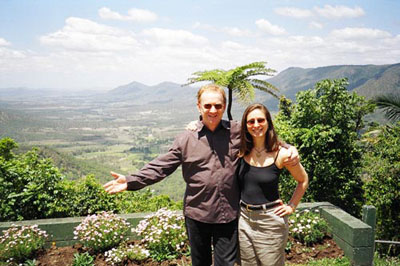 Graeme Connors and Debbie at Eungella, near Mackay
Graeme Connors and Debbie at Eungella, near Mackay
|
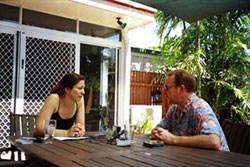 |
We did the interview over two days. Graeme likes to drive, so on the first day of interviewing we drove around the Mackay area, into the Pioneer Valley and up to Eungella. On the second day we decided to remain stationary, and talked in his back garden. It was a very long, detailed interview, as I had anticipated it would be with someone so good at articulating the creative experience. |
|
| Once the interview was done, that left a couple of days to explore the region. I'd never been to the Whitsunday Coast before, so I gladly took the opportunity. |
| I borrowed the Connors family ute and drove up to Airlie Beach for a night, followed by a day of cruising to a couple of the Whitsunday islands.
And on my final day, Graeme and his wife Lyn showed me some of the beaches around Mackay. If only all interview trips could have been so balmy!
|
 Lyn and Graeme Connors
Lyn and Graeme Connors
|
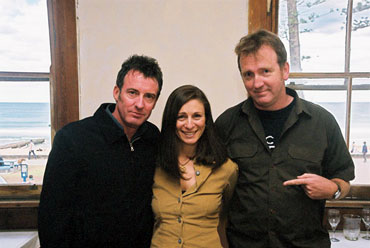 Author poses happily between the Oils' Rob and Jim
Author poses happily between the Oils' Rob and Jim
|
A week before the Mackay trip I'd done my interview with the songwriting geniuses of Midnight Oil – Rob Hirst and Jim Moginie. We met at a cafe at Manly Beach, whose staff very kindly gave us the upstairs dining space for three hours. There we could look out to the Norfolk Island pines they'd written about in "Dreamworld". |
| I didn't want to ask them to rehash political views, as so many interviewers have done before. I wanted them to talk about how they made the music. Rob and Jim appreciated that, and rewarded me with a detailed and candid interview. As photographer John Elliott and I were leaving, Rob said to me, "You ask good questions!" The perfect compliment. |
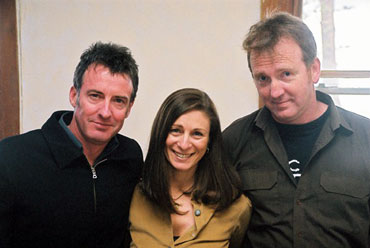 |
| This is me with John Elliott, a seriously gifted photographer, whose images were shown in an exhibition called "Thousand Mile Stare" at the National Portrait Gallery in early 2005. |
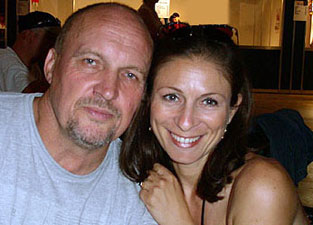 |
John was Slim Dusty's favoured photographer and has done words and photos for books on Slim, Lee Kernaghan and others. To have his work, along with Bob King's and Henry Diltz's, in my book, was a great honour. |
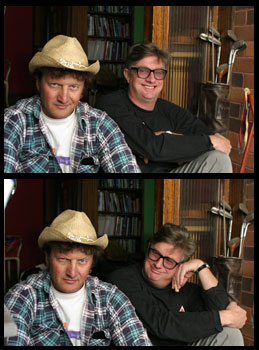 |
But back to the songwriters. Not all the great tunesmiths in our musical history have written of serious issues – although one might argue that drinking, partying, cars and affairs of the heart are as serious as it gets. Mental As Anything's Martin Plaza and Greedy Smith shared their thoughts on songwriting with me in two separate interviews. Both took place at Martin's house in a beach-side suburb of Sydney, a couple of weeks apart in April and May 2004.
Martin was in the middle of finishing paintings for a new art exhibition when I first went to see him. Greedy drove in from his home just outside of Sydney to do his interview, and to join Martin in a photo shoot with my friend Keith Saunders, who took some seriously classy pictures. The ones here are, of course out-takes.
|
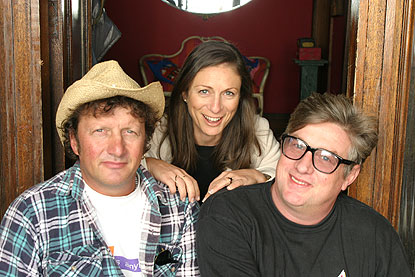 Martin Plaza and Greedy Smith with author-as-anything Debbie
Martin Plaza and Greedy Smith with author-as-anything Debbie
|
|
Martin Plaza on "The Nips Are Getting Bigger":
The melody popped into my head when I was driving across the Harbour Bridge one day in my ’63 V-Dub. I kept singing it all the way, I was living at Chippendale at the time and I got on my guitar, I put the chords around it, and I just threw the words together really quickly. I was actually having a drink while I was doing it.
Greedy Smith on "You're So Strong":
The idea of that is a bit of a feminist fellow-traveller idea. “You mightn't think so but I know, you're so strong.” It’s like supporting a woman. Sometimes, particularly when they’re hanging around the blokes, they quite often seemed to be voices lowered, there’s not the same sort of braggadocio that you get with blokes. Maybe it was just me but I used to end up with really strong women. In fact I’ve gone from strength to strength as far as women go now. Now I’m just scared of my wife.
|
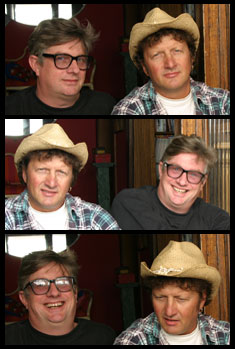 |
| In May 2004, just before heading overseas to do more interviews, I made my second book trip up to Queensland. This time my destination was Brisbane, and the magnificent, brand-new waterfront home and studio of Daniel Jones, one half of Savage Garden.
Daniel doesn't do many interviews, certainly none as in-depth as the one he did with me. He was always the quieter, more private half of Savage Garden. We already knew each other from my time at APRA, as he was a regular presenter and winner at the APRA Music Awards, and he willingly participated in my book.
|
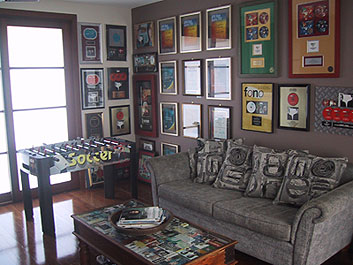 Photo ©Meridien Musik
Photo ©Meridien Musik
|
Daniel was still putting the finishing touches to his dream house, but the studio was completed, and that's where we sat and talked for two hours about his songwriting. This was the new headquarters for his independent publishing and artist development company Meridien Musik. Check out the studio's website to see more of the beautiful setting in which my interview with Daniel took place, on a gloriously warm and sunny Brisvegas day. |
| Of course both Tim and Neil Finn were essential ingredients of this book, and the key reason I couldn't really call it Australian Songwriters on Songwriting or in any way confine it to being about just Australians. They are New Zealanders through and through. They are both living full-time back in Auckland, yet intrinsically part of the fabric and history of Australian music. Whatever I ended up calling the book, they had to be in it.
I interviewed Tim in two stages. The first half of his interview took place in Sydney in December 2003, while he was on a pre-Christmas holiday with his wife and kids. He was generous with his thoughts and recollections of songwriting through his career, and we ran out of time. I said I needed to be in Auckland in February to interview Neil (and do some other business), so we adjourned until then. Sure enough, we completed his interview six weeks later in his tranquil home in one of Auckland's most picturesque suburbs.
|
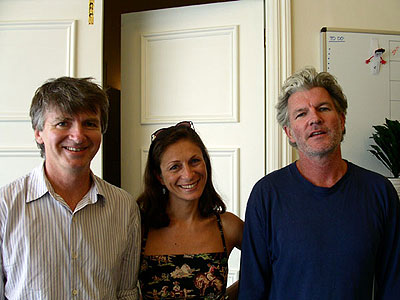 Debbie experiences something so Finn
Debbie experiences something so Finn
Auckland, February 2004
|
The next day I met with Neil in his new studio space, a vast converted warehouse behind his wife Sharon's chandelier shop in inner-city Auckland. After we finished, who should pop in for a visit but Tim, along with a couple of their friends, one of whom kindly took this happy snappy for me. Too good an opportunity to miss, I figured. |
| After interviewing my way around Sydney and environs, doing three Melbourne trips, two to Queensland, a hop over to New Zealand, and some earlier interviews in Los Angeles, it was time to head over to England and back to LA to meet with the remaining overseas-based songwriters. |
| And so back to that phone call from Terry Britten, during dinner at Glenn Shorrock's house in May 2004, and soon after, a District Line tube from London to Richmond in Surrey, on a gorgeous Spring day, to meet with the Grammy-winning songwriter and producer who started his musical career in Adelaide band, The Twilights.
He visits his parents back in Adelaide each year, but always keeps a low profile, so meeting him on his own turf in England was perfect.
|
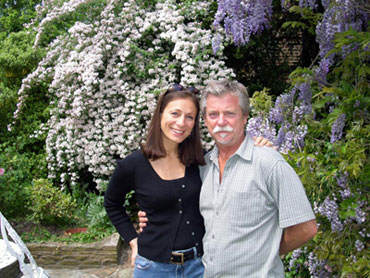 In an English country garden this pretty, it's obvious what love's got to do with it. Debbie with Terry Britten, May 2004
In an English country garden this pretty, it's obvious what love's got to do with it. Debbie with Terry Britten, May 2004
|
| Terry Britten doesn't do many interviews; I'm not sure he normally does any. He's the quintessential humble man behind the scenes, and the gentlest of souls. He gave me a little driving tour of Richmond, showing me where some of the local rock stars, like Mick Jagger and Pete Townsend, live, saying he runs into them sometimes at the garden centre. |
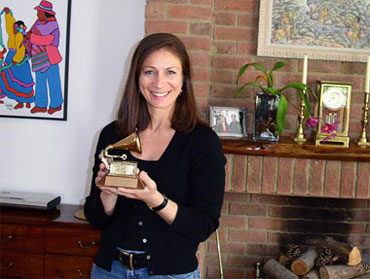 |
His many hit songs include "Devil Woman" for Cliff Richard and the song that turned around the fortunes of Tina Turner, "What's Love Got To Do With It", but he said to me quite genuinely, "I don't see myself as a professional songwriter." Hmmm, right, okay. He's also written for Michael Jackson, Lenny Kravitz and Bonnie Raitt. Oh, and Australia's one-time pop queen, Christie Allen. |
| He wouldn't dream of doing something so tacky as posing for a photo holding one of his many awards, but when I asked if I could pick up a Grammy from his mantelpiece – being that I'd never seen let alone held one before – he grabbed my camera and took this shot of me, above. |
| I sent my old high school friend, Andrew Murray, a celebrity and portrait photographer based in London, down to Richmond a few months later to take Terry's photo. No Grammy in sight, of course. |
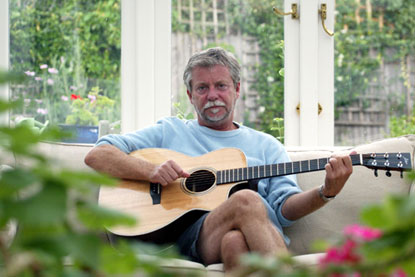 |
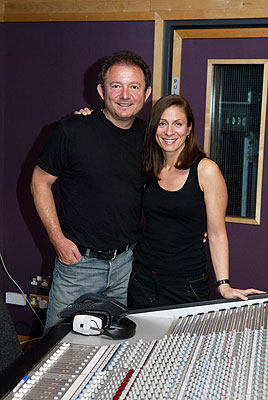 Steve Kipner and Debbie
Steve Kipner and Debbie
London, May 2004
|
Andrew came with me to the famous Olympic Studios in Barnes, just past Hammersmith, to take some photos of Steve Kipner.
I'd already interviewed Steve in LA in September 2002, and planned to get his photo on my return to LA during the 2004 trip. But as it turned up he was based in London for the summer working with his new talent, Natasha Bedingfield, whose single, aptly titled "Single", co-written by Steve, was atop the UK charts that week. When we'd first met in LA, 20 months earlier, Kelly Rowland (Destiny's Child) had sung another of his songs, "Stole", to the top of various US charts.
Steve Kipner is the ultimate pop songwriter, and he's loving it. Like I said at the beginning of his chapter in my book, he's excited. Always excited.
|
| I was having a busy time interviewing in and around London. I'd met with Darren Hayes, the other half of Savage Garden, a couple of days before visiting Terry Britten, and I arranged the Steve Kipner photo shoot on my way down to England's south coast for my Nick Cave interview the following day. |
| And then, two days after I visited Nick Cave in Hove, it was out to Bray in Oxfordshire for a few hours in the company of the legendary Rolf Harris.
In some ways it's like time stands still at the Harris home, which is probably what he needs given his crazily hectic schedule, shooting television series, doing live performances, painting, and just being Rolf.
|
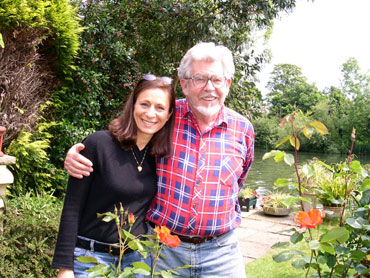 |
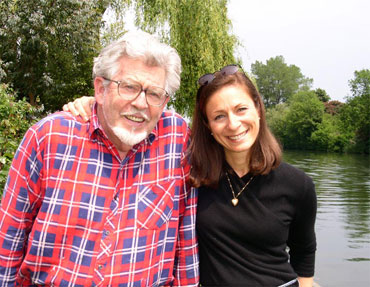 |
During our interview Rolf sang several of his songs to me, either in part or in their entirety. He spoke eloquently and most knowledgably about many genres of music, and spoke fondly and with great admiration about many of the other songwriters I had interviewed for the book. And he graciously posed for photos with me in his riverside garden, his wife Alwen doing a fine job with the camera. |
|
| Rolf also demonstrated for me his "Instant Music", a shorthand way of writing music notation when composing on the hop. Appropriately, the sample he gave me was the opening bars of "Tie Me Kangaroo Down, Sport". It was a particularly satisfying end to two weeks of interviewing in England. |
|
|
| And then it was over to California, where I hooked up with my dear friend Henry Diltz, the most legendary photographer of them all. Together we paid a visit to Malibu, and the home of John Farrar, whom I'd already interviewed in 2002, to do a photo shoot.
If talking about himself is only a little more bearable than tooth extraction for the diffident songwriter/producer/guitarist, having his photo taken is probably slightly less uncomfortable. But Henry did his magic quickly and effectively.
|
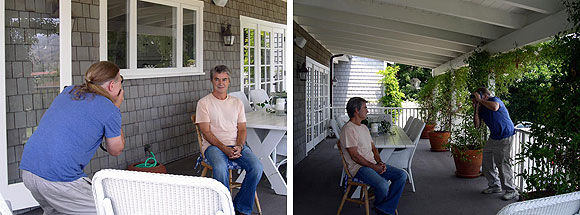 Diltz shoots Farrar, painlessly
Diltz shoots Farrar, painlessly
|
| John Farrar wrote the two biggest hits from Grease, which scores him top points before even looking at the rest of his wonderful catalogue of songs. Here's a snippet of what he said on each. |
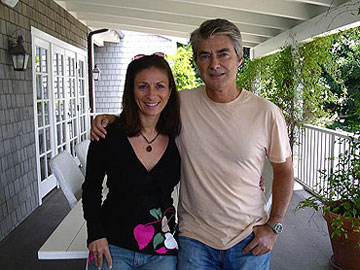 Debbie with John Farrar, June 2004
Debbie with John Farrar, June 2004
|
"You're The One That I Want":
The weird thing was it was the fastest song I ever wrote. It came so fast, the actual melody and the feel of it.
"Hopelessly Devoted To You":
I spent the longest period writing the lyrics of any song I’ve ever written. Every thesaurus and every rhyming dictionary I had, just trying to really make it work properly.
|
| Hidden away in Topanga Canyon is Colin Hay's gorgeous love shack (actually, a stone cottage) and studio. Henry came with me and clicked away throughout the interview, which is how Henry likes to work. Henry also likes to photograph mosaic tables, jewellery and body parts. On this day it was just the mosaic table. |
 Interview in sepia, June 2004
Interview in sepia, June 2004
|
 |
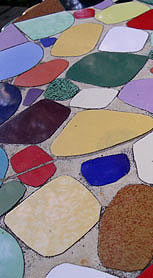 |
| Colin Hay is Scottish-born, Australian-raised, and has lived in LA for some years now, so he is a real hybrid. A great raconteur, he tells his stories of kissing girls and writing songs in a sing-song Scottish lilt, with a dry humour, and an elfishly expressive face. |
|
|
|
|
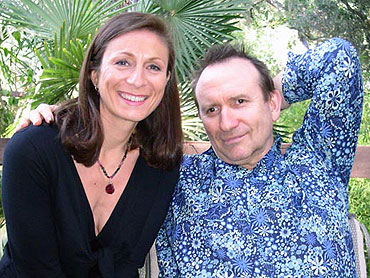 Debbie and Colin Hay
Debbie and Colin Hay
|
| After my last overseas trip for the book, I only had one more songwriter to interview. I'd been trying to track down Archie Roach all through 2004, and fortunately I was able to meet up with him in Sydney on the day after the Deadly Awards, and we sat in a park near the house of some of his relatives. Bob King was on hand to do pics. |
| In some ways it was a most fitting closing interview for the book, talking to this most Australian of songwriters. It felt like quite a privilege to be with Archie, hearing him share stories that I knew he had shared before, but telling them as if for the first time. Coming from a lineage of storytellers, he feels it is part of his calling to keep telling his story of being part of the stolen generation, especially through his songs. |
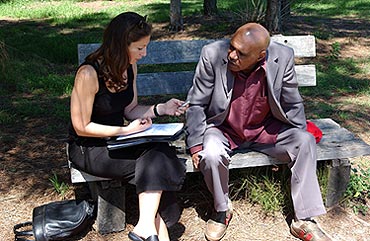 Debbie interviews Archie Roach, October 2004
Debbie interviews Archie Roach, October 2004
|
 |
 |
| I was already well into the book when I started keeping a tally of where I was up to on a whiteboard in my home office. While I was busy preparing for some interviews, I was trying to keep up with the transcribing of those I had done, editing those down and writing introductions to each one, chasing up songwriters for their release forms if they had asked for time to sign it, and organising photos for each songwriter. |
|
|
| Getting a good interview was one thing; having a good quality recording of the interview was just as important. There was a scary moment or two during the interviewing process. My much-loved and well-worn Sony Professional Walkman tape recorder decided it didn't want to play during my Ross Wilson interview, and Ross brought out his dinky little tape recorder so that I could finish the recording. Thank heavens for songwriters' recording devices! |
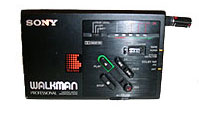 |
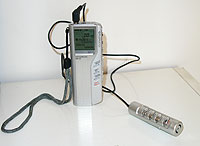 |
Finally I got myself an Olympus digital voice recorder, which improved the sound quality of the recordings, for one thing, and enabled me to in fact record with two devices and always have a back-up. Transcribing from a digital system with no delicate tape involved is generally a safer bet. |
The transcribing was by far the most laborious part of the entire process. I think I've worked out that around half a million words were transcribed from the recorded interviews. I had some hairy moments; during the transcribing of Brian Cadd and Garth Porter, the transcribing machine chewed up my tapes – which I had not made duplicates of – and some salvage operations were necessary, with precision splicing.
I also had some enjoyable moments; transcribing some of the great conversations, like the one with Nick Cave, allowed me to enjoy them all over again. I hadn't realised how much Nick and I had laughed together until I listened to the tape. Some, like Don Walker, Sharon O'Neill and Graeme Connors, spoke so clearly, articulated themselves so well, that it was a pleasure to type up their words. Others, whose names I won't mention, I could cheerfully have strangled had they been with me while I was transcribing. It was a happy day when all the transcribing was finished.
|
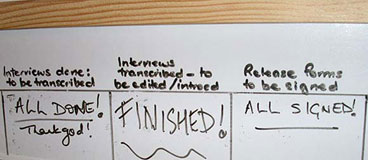 |
I finished the transcribing in November 2004, at which time I still had about 13 chapters to write. Needless to say, I spent that Christmas/New Year break working my butt off.
At around this time, my publisher gave me a word limit that meant a lot of cutting would have to be done, so I spent all of January pruning my chapters. Or, as a few writer friends of mine call it, "cutting my darlings". Self-editing is ultimately a better way to go, but my god it is heartbreaking.
|
|
 |
| Still, I was happy with the end result – 40 chapters containing 43 individual interviews that were reproduced as faithfully as possible, and still at a greater length than other interviews that have ever been published with any of these artists. I delivered the finished manuscript on 1 February 2005, feeling like I had just given birth.
In the months that followed, there were edited proofs to go through, designs to agree on, preliminary pages to write, and meetings to attend with the publisher, publicist and record company. Plus permissions to obtain for reprinting lyric lines from some 80 songs! Writing a book sure ain't just about the writing.
Oh, and the title of the book had been decided on by November 2004. After giving up trying to find a song title that would work (what a pity an Australasian tunesmith didn't write "I Write The Songs"), I chose the concise, descriptive Songwriters Speak.
|
 |
 |
Books. Music books. Wonderful things. I can't get enough of them, but they have to be good music books – well written, and on a subject I'm interested in, of course. Sadly, there are a lot of badly written, boring books out there about music, but on my Essential Reading page you'll see a long list of mostly great books, some of which I referenced when researching Songwriters Speak. |
| I've already mentioned Paul Zollo's wonderful Songwriters on Songwriting, which was my greatest inspiration. I also couldn't have done a lot of my research without Ian McFarlane's The Encyclopedia of Australian Rock and Pop, which is my bible for Australian music.
There were individual biographies to read – as diverse as Rolf Harris and Nick Cave – and songwriting manuals to peruse.
|
 |
| Naturally I used the internet relentlessly. Milesago is just terrific, as is Howlspace, and all the artist's official and fan websites offered much information.
And then there was the music. Hundreds of CDs were listened to for research purposes. In some cases it was like re-living eras past, hearing songs again that I hadn't heard in years. In other cases it was eye-opening, as I immersed myself in the music of artists I hadn't necessarily been into previously.
|
 |
| And then the book was printed and in my hands... Quite a happy day! |
|
|
| And in the bookshops... Even better! |
|
|
|
|
|